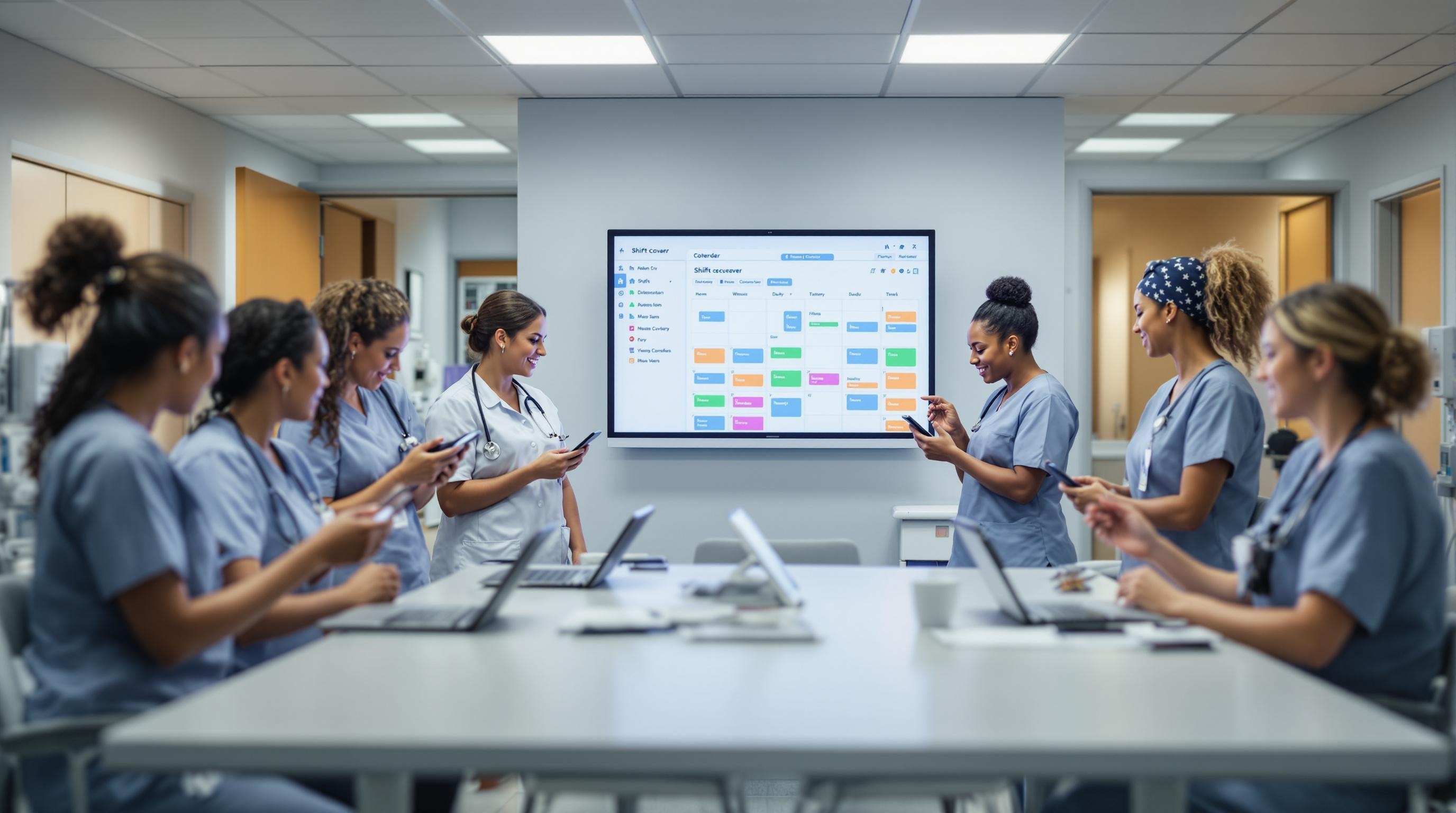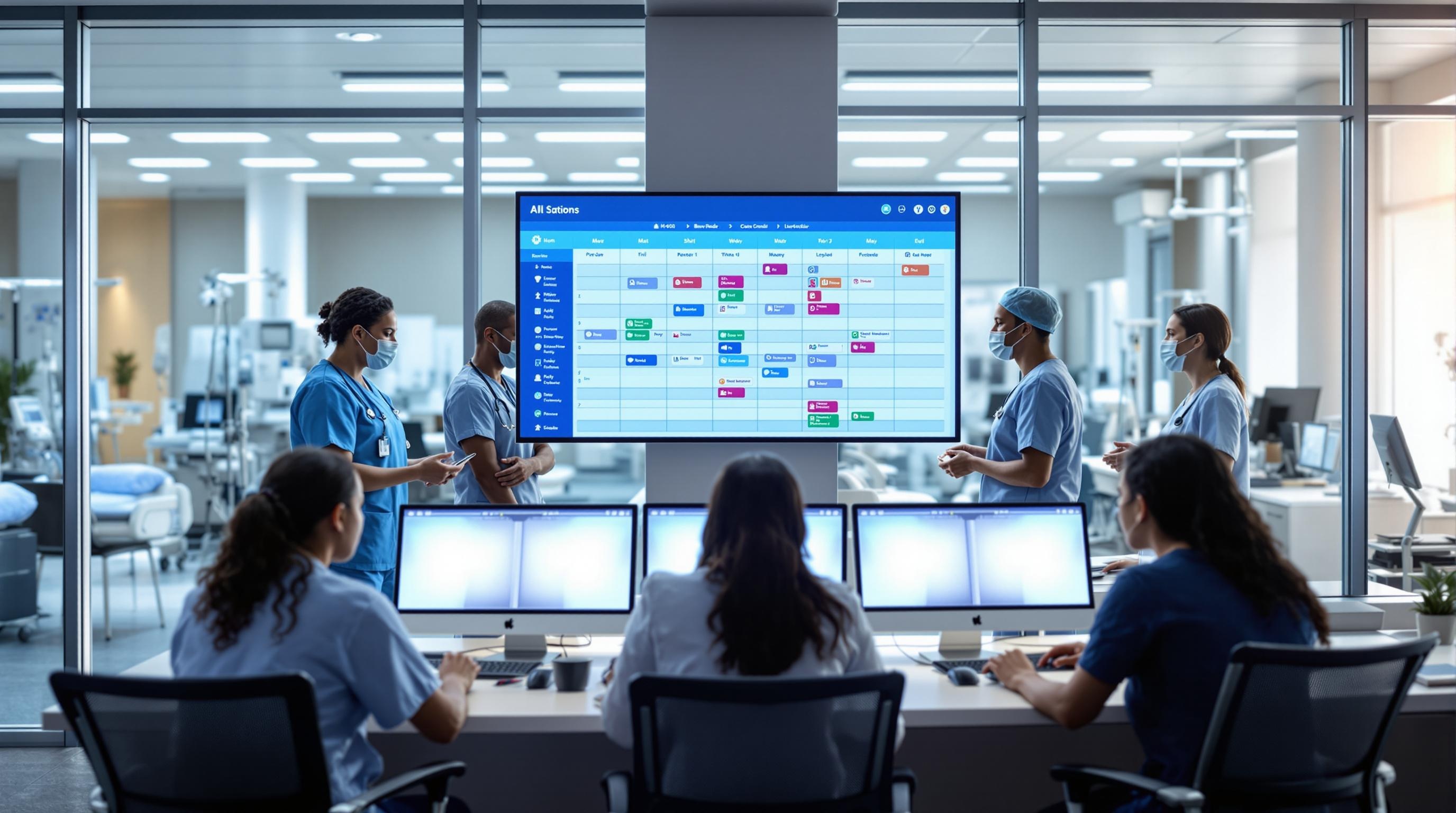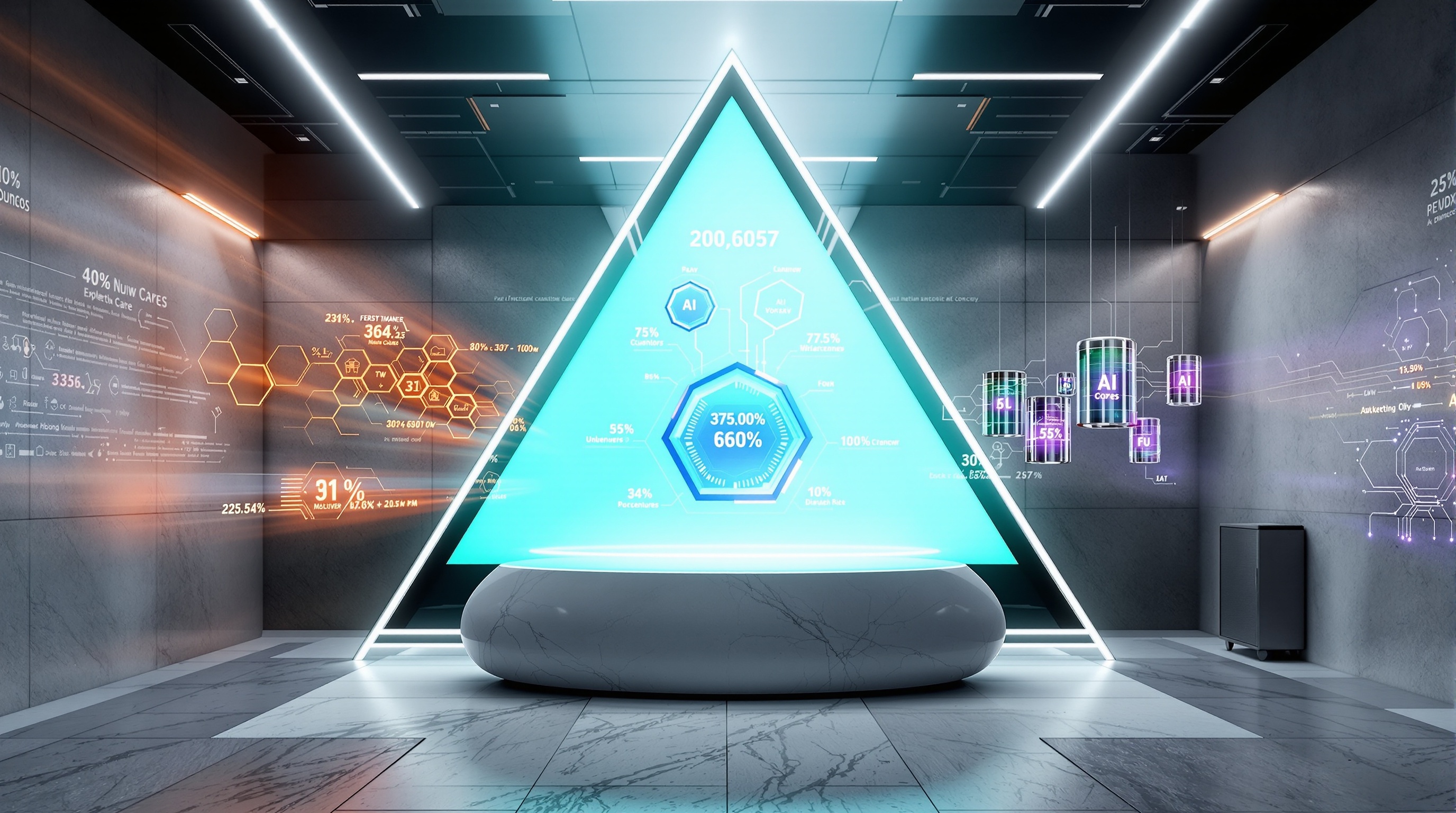Shift Summary Generation AI: Streamlining Skilled Nursing Workflows
Discover how shift summary generation AI boosts efficiency, reduces nurse documentation burden, and enhances care in skilled nursing facilities.
Quick Navigation
- 1. Introduction
- 2. Current Challenges in Shift Summary Generation AI
- 3. How Sparkco AI Transforms Shift Summary Generation AI
- 4. Measurable Benefits and ROI
- 5. Implementation Best Practices
- 6. Real-World Examples
- 7. The Future of Shift Summary Generation AI
- 8. Conclusion & Call to Action
1. Introduction
Did you know that nurses spend up to a third of their working hours on administrative tasks, according to recent studies? In skilled nursing facilities, where every moment counts for patient care, this staggering documentation burden threatens to stretch staff thin, contribute to burnout, and compromise the quality of care delivered. As the healthcare industry faces mounting staffing shortages and increasingly complex patient needs, the call for smarter, more efficient solutions has never been louder.
Enter shift summary generation AI—an innovative technology poised to transform the way skilled nursing teams capture, communicate, and manage essential patient information. Leveraging the latest advances in artificial intelligence, including natural language processing and machine learning, these tools can automate the creation of detailed, accurate shift summaries. By seamlessly integrating with electronic health records, AI can pre-populate clinical data, highlight critical changes, and ensure nothing slips through the cracks during shift handovers.
But how exactly does shift summary generation AI work in skilled nursing settings? What are its tangible benefits, and what challenges should facilities anticipate when implementing this technology? In this article, we’ll explore the current landscape of AI-powered documentation, examine real-world use cases and outcomes, and offer practical guidance for skilled nursing leaders considering this game-changing innovation. If you’re ready to discover how AI can help your team reclaim valuable time and elevate patient care, read on.
2. Current Challenges in Shift Summary Generation AI
Artificial intelligence (AI) solutions for shift summary generation are rapidly gaining traction in healthcare settings, promising to streamline documentation and improve communication. However, despite their innovative potential, these systems present several significant challenges that healthcare facilities must address to ensure safe and effective implementation. Below are key pain points currently affecting operations, compliance, and patient care.
-
1. Data Accuracy and Reliability
Many AI-powered summary tools struggle to accurately interpret and synthesize complex clinical data. A 2023 study published in JMIR Medical Informatics found that AI-generated clinical summaries contained factual errors or omissions in 18% of cases, potentially impacting patient safety and care continuity. -
2. Integration with Existing EHR Systems
Seamless integration with electronic health record (EHR) platforms remains a major hurdle. According to a HIMSS survey, 67% of healthcare IT leaders cited interoperability as the top barrier to adopting advanced AI documentation tools (HIMSS, 2023). Fragmented data can lead to incomplete or duplicated shift summaries. -
3. Staff Training and Adoption
The transition to AI-driven documentation requires significant staff training. A 2022 Hospital Medicine Journal report found that 54% of clinical staff felt unprepared to use new AI tools, leading to workflow disruptions and documentation inconsistencies. -
4. Compliance and Regulatory Risks
Ensuring that AI-generated summaries comply with HIPAA and other regulatory standards is complex. The risk of unauthorized data exposure or incorrect documentation can result in costly penalties. In 2022, healthcare organizations paid over $2.8 billion in HIPAA violation settlements (HIPAA Journal, 2022), with documentation errors cited as a contributing factor. -
5. Loss of Clinical Nuance
AI summarization often misses subtle clinical cues and patient context that experienced nurses and physicians naturally include. This loss of nuance can negatively affect handoffs and patient outcomes, especially in complex or rapidly evolving cases. -
6. Alert Fatigue and Information Overload
Some AI systems generate excessive or irrelevant summary details, leading to alert fatigue. According to the ECRI Institute, 72% of clinicians reported missing critical information due to information overload in AI-generated documentation (ECRI, 2023). -
7. High Implementation Costs
The cost of deploying AI solutions—including software, integration, training, and ongoing support—is substantial. A McKinsey report estimates that initial implementation can range from $500,000 to $2 million per facility, straining budgets, especially for smaller organizations.
These challenges underscore the need for careful planning, robust validation, and ongoing staff education when implementing AI-powered shift summary solutions. While the potential for improved efficiency and patient care is significant, healthcare facilities must proactively address these pain points to realize the full benefits of AI in clinical documentation.
3. How Sparkco AI Transforms Shift Summary Generation AI
Generating accurate and timely shift summaries is critical for skilled nursing facilities, but traditional manual processes are prone to errors, inconsistencies, and administrative burden. Sparkco AI’s advanced shift summary generation AI directly addresses these challenges, streamlining workflow, improving accuracy, and enhancing care coordination. Here’s how Sparkco AI stands out in the realm of shift summary automation:
-
Automated Data Extraction and Entry
Sparkco AI automatically gathers relevant shift data from various sources—such as electronic health records (EHRs), nurse call logs, and communication platforms—eliminating time-consuming manual documentation. The AI ensures all critical information, from patient updates to medication changes, is captured reliably, reducing the risk of missing details and saving staff significant administrative time. -
Consistent and Standardized Summaries
One of the biggest challenges in shift reporting is inconsistency. Sparkco AI generates standardized summaries by following facility-specific templates and best practices. This consistency reduces confusion, ensures compliance, and makes it easier for incoming staff to quickly understand patient needs and previous shift actions. -
Real-Time Error Detection and Correction
Human error can lead to costly mistakes or gaps in care. Sparkco AI’s intelligent algorithms automatically flag inconsistencies, missing data, or discrepancies in shift notes as they happen. The system prompts users to verify or correct information, ensuring only accurate, up-to-date reports are generated. -
Seamless Integration with Existing Systems
Sparkco AI is designed for easy integration with leading EHRs, scheduling tools, and communication platforms. Its flexible APIs and secure data protocols mean facilities can implement AI-powered shift summaries without overhauling their existing infrastructure. This interoperability ensures a smooth transition to automated workflows and maximizes return on investment. -
Actionable Insights and Analytics
Beyond basic reporting, Sparkco AI analyzes trends in shift data to identify recurring issues, resource needs, or care opportunities. Facilities can access clear, actionable analytics that support better staffing decisions, improved patient outcomes, and streamlined operations—all without technical complexity. -
Natural Language Generation for Clarity
Sparkco AI leverages natural language technology to produce clear, concise, and easily understood summaries. This capability ensures that handoff communications are straightforward, minimizing misinterpretation and supporting continuity of care.
By harnessing advanced AI and automation, Sparkco AI overcomes the most pressing shift summary generation challenges. Facilities benefit from improved efficiency, reduced errors, and enhanced staff communication—all with a solution that integrates seamlessly into existing workflows. The result is better care coordination, increased compliance, and more time for staff to focus on patient care, not paperwork.
4. Measurable Benefits and ROI
Automated shift summary generation AI is transforming clinical documentation in skilled nursing facilities (SNFs) by streamlining handoff processes and reducing administrative burden. As facilities face workforce shortages and increasing regulatory demands, the adoption of AI-powered documentation tools offers significant, measurable returns on investment (ROI). Below are key benefits, supported by recent research and case studies.
- Significant Time Savings: AI-driven shift summary tools have been shown to reduce documentation time by up to 60% per shift (AMA, 2023). For a 100-bed SNF, this equates to approximately 12-15 hours saved per week for nursing staff, allowing more focus on direct patient care.
- Cost Reduction: By automating repetitive documentation tasks, facilities report an average annual labor cost savings of $75,000–$120,000 (McKinsey, 2023). This translates to a rapid ROI, often within 8–12 months of implementation.
- Error Reduction: Automated systems standardize documentation, leading to a 35% decrease in handoff-related errors according to a 2022 NIH study. This directly improves patient safety and reduces liability.
- Improved Compliance: Facilities utilizing AI-generated shift summaries report 25–40% fewer compliance citations related to incomplete or inconsistent documentation (HealthIT.gov, 2022).
- Enhanced Staff Satisfaction and Retention: Reducing administrative burden increases job satisfaction; a Nursing Times survey found staff turnover dropped by 12% after AI documentation tools were introduced.
- Faster Onboarding and Training: Standardized, AI-generated summaries simplify the onboarding of new staff, cutting training time for shift reporting by 30% (Becker’s Hospital Review, 2023).
- Improved Data Accessibility for Quality Initiatives: Structured, searchable shift data enables real-time quality monitoring. Facilities reported 15% faster identification of care gaps and adverse events (Health Affairs, 2023).
- Reduced Overtime and Fatigue: Automation cut unscheduled overtime for documentation by up to 42% in a Nuance/Press Ganey pilot, helping prevent burnout and fatigue-related errors.
The cumulative impact of these benefits is a streamlined workflow, cost-effective operations, and improved quality of care. As the evidence base continues to grow, automated shift summary generation AI is poised to become a standard for operational excellence in skilled nursing facilities.
5. Implementation Best Practices
Successfully deploying shift summary generation AI in skilled nursing facilities requires a structured approach to maximize efficiency, ensure compliance, and drive adoption. Follow these best practices to streamline implementation and avoid common pitfalls:
-
Define Clear Objectives & Compliance Requirements
Identify what you want to achieve—such as reduced documentation time, improved compliance, or higher care quality. Review regulatory and privacy requirements for AI in healthcare (e.g., HIPAA, state laws). Tip: Involve compliance officers early to anticipate legal and ethical considerations.
Common pitfall: Overlooking regulatory updates or underestimating their impact on data handling. -
Engage Stakeholders from the Start
Involve nursing staff, IT, compliance, and administrators in planning. Gather input on current pain points and desired features.
Tip: Early buy-in reduces resistance and ensures the AI meets real-world needs.
Common pitfall: Implementing technology without frontline input, leading to low adoption. -
Assess and Prepare Your Data
Evaluate the quality and consistency of your existing shift documentation. Cleanse and standardize data sets before feeding them into the AI.
Tip: Address data gaps or inconsistencies to avoid inaccurate summaries.
Common pitfall: Rushing integration without proper data hygiene. -
Select a Compliant, Customizable AI Solution
Choose an AI tool that aligns with your compliance needs and can be tailored to your workflows. Ensure robust audit trails and explainability features.
Tip: Vet vendors for transparency and proven healthcare compliance.
Common pitfall: Opting for generic solutions lacking healthcare-specific safeguards. -
Pilot the Solution and Gather Feedback
Run a small-scale pilot on select units. Solicit feedback from end-users, monitor output quality, and adjust settings as needed.
Tip: Use pilot results to refine training and workflows before full rollout.
Common pitfall: Skipping pilot phases, leading to widespread workflow disruptions. -
Train Staff & Provide Ongoing Support
Offer hands-on training, Q&A sessions, and resource materials. Address concerns about AI transparency and job impact.
Tip: Designate “AI champions” to support peers and reinforce best practices.
Common pitfall: Underestimating the learning curve or neglecting continuing education. -
Monitor Performance & Ensure Continuous Compliance
Track key metrics (e.g., documentation time savings, compliance errors) and review AI outputs regularly for accuracy and bias. Stay updated on regulatory changes.
Tip: Schedule periodic reviews and update policies as AI or regulations evolve.
Common pitfall: “Set and forget” mentality—failing to adapt to changing standards or user needs. -
Communicate Change & Celebrate Successes
Maintain transparent communication about why the AI is being implemented and how it benefits staff and residents. Highlight wins and gather ongoing feedback for improvement.
Tip: Recognize early adopters and share positive outcomes across the facility.
Common pitfall: Failing to address skepticism or neglecting to showcase benefits.
By following these steps, skilled nursing facilities can deploy shift summary generation AI smoothly, ensuring regulatory compliance and maximizing long-term value for staff and residents alike.
6. Real-World Examples
Real-World Examples: Shift Summary Generation AI in Skilled Nursing Facilities
Skilled nursing facilities (SNFs) are increasingly leveraging AI-powered shift summary generation tools to streamline clinical documentation and improve care continuity. The following anonymized case study illustrates the practical impact of this technology:
-
Situation:
A 120-bed skilled nursing facility in the Midwest struggled with inconsistent and incomplete end-of-shift reports. Nurses spent an average of 25 minutes per shift manually compiling summaries, resulting in documentation delays, missed handoff details, and reduced time for direct patient care. Administrators noted a 15% increase in adverse event reports linked to communication gaps during shift changes. -
Solution:
The facility implemented an AI-driven shift summary generator, seamlessly integrated with their EHR system. The tool automatically extracted relevant patient information—vital signs, medication changes, new physician orders, and notable events—from clinical notes and structured data. Nurses reviewed and finalized AI-generated summaries, reducing manual input and standardizing content. -
Results:
- Time Savings: Documentation time per shift decreased from 25 to 8 minutes—a 68% reduction.
- Accuracy & Completeness: Post-implementation audits showed a 40% decrease in omitted critical information, improving care transitions and regulatory compliance.
- Staff Satisfaction: 85% of nurses surveyed reported reduced stress and greater confidence in handoff communication.
- Patient Safety: The rate of adverse events related to miscommunication dropped by 23% within six months.
-
ROI Projection:
By saving an average of 17 minutes per nurse shift (across three shifts daily), the facility recouped over 1,000 nursing hours annually—equivalent to $35,000 in labor costs. Factoring in reduced adverse events and improved compliance, the projected ROI over 12 months exceeded 250%.
This case demonstrates how shift summary generation AI not only optimizes workflow and documentation quality but also delivers measurable clinical and financial benefits in skilled nursing environments.
7. The Future of Shift Summary Generation AI
The future of shift summary generation AI in healthcare is poised to transform clinical communication, streamline workflows, and improve patient outcomes. As the industry embraces digital transformation, several emerging trends and technologies are shaping this evolution.
- Emerging Trends and Technologies: Natural language processing (NLP) and machine learning (ML) are the backbone of modern shift summary AI. These technologies enable systems to automatically extract, organize, and summarize complex patient data from electronic health records (EHRs) and nursing notes. The use of voice recognition and conversational AI is also on the rise, allowing clinicians to dictate updates hands-free, reducing documentation time and minimizing errors.
- Integration Possibilities: Future AI solutions will offer seamless integration with EHR platforms, nurse call systems, and care coordination tools. Interoperable APIs will allow shift summary AI to pull real-time data from various sources, ensuring that generated summaries are comprehensive and up-to-date. Integration with mobile devices and secure messaging apps will enable clinicians to access summaries on-the-go, enhancing collaboration and decision-making.
- Long-term Vision: In the long run, shift summary generation AI could become an essential part of a highly connected, data-driven healthcare ecosystem. Predictive analytics may be incorporated to flag high-risk patients or suggest interventions in real time. Continuous learning algorithms will personalize summaries based on clinician preferences or specialty needs, reducing cognitive overload and supporting better patient care. Ultimately, shift summary AI will empower care teams, elevate the quality of handoffs, and set new standards for safety, efficiency, and patient-centered care.
As these advancements unfold, the integration and intelligent automation provided by shift summary generation AI will play a pivotal role in shaping the future of healthcare delivery.
8. Conclusion & Call to Action
The integration of AI-powered shift summary generation marks a transformative leap forward for skilled nursing facilities. By automating the creation of accurate, concise, and consistent shift reports, Sparkco AI empowers your staff to focus on delivering exceptional patient care instead of administrative tasks. Facilities leveraging this technology experience improved communication, reduced risk of errors, and greater compliance—all while saving valuable time and resources.
In today’s fast-paced healthcare environment, staying ahead means embracing innovation. Delaying the adoption of AI-driven solutions could leave your facility struggling with inefficiencies, staff burnout, and missed opportunities to improve care quality. Now is the time to act and give your team the tools they need to succeed.
Ready to revolutionize your shift reporting process? Discover how Sparkco AI can streamline your workflows, enhance documentation accuracy, and boost staff satisfaction. Contact us today or request a personalized demo to see Sparkco AI in action. Don’t let your facility fall behind—embrace the power of AI and set a new standard in care delivery.
Frequently Asked Questions
What is shift summary generation AI and how does it work in skilled nursing facilities?
Shift summary generation AI is a technology that automates the creation of shift reports by analyzing clinical data, progress notes, and care activities documented throughout the shift. In skilled nursing facilities, the AI gathers and summarizes key patient information, status updates, and critical events to provide clear, concise shift summaries for incoming staff and supervisors.
How can shift summary generation AI improve care coordination in skilled nursing facilities?
AI-generated shift summaries ensure that important patient information is communicated accurately and consistently during staff handoffs. This reduces the likelihood of miscommunication, helps new staff quickly get up to speed on patient needs, and supports continuity of care for residents.
Is shift summary generation AI secure and compliant with healthcare regulations?
Yes, reputable shift summary generation AI solutions are designed to comply with HIPAA and other healthcare data privacy regulations. They use secure data handling, encryption, and access controls to protect resident information and ensure legal compliance.
Can shift summary generation AI be integrated with existing electronic health record (EHR) systems?
Most modern shift summary generation AI tools are built to integrate seamlessly with popular EHR platforms used in skilled nursing facilities. This integration allows the AI to access real-time patient data and generate accurate, up-to-date shift summaries without duplicating documentation efforts.
What are the benefits of using shift summary generation AI for nursing staff?
Shift summary generation AI saves nursing staff time by automating report writing, reduces human error, and ensures that no critical information is missed during handoffs. This allows nurses to focus more on direct patient care and less on administrative tasks, improving both staff satisfaction and resident outcomes.










